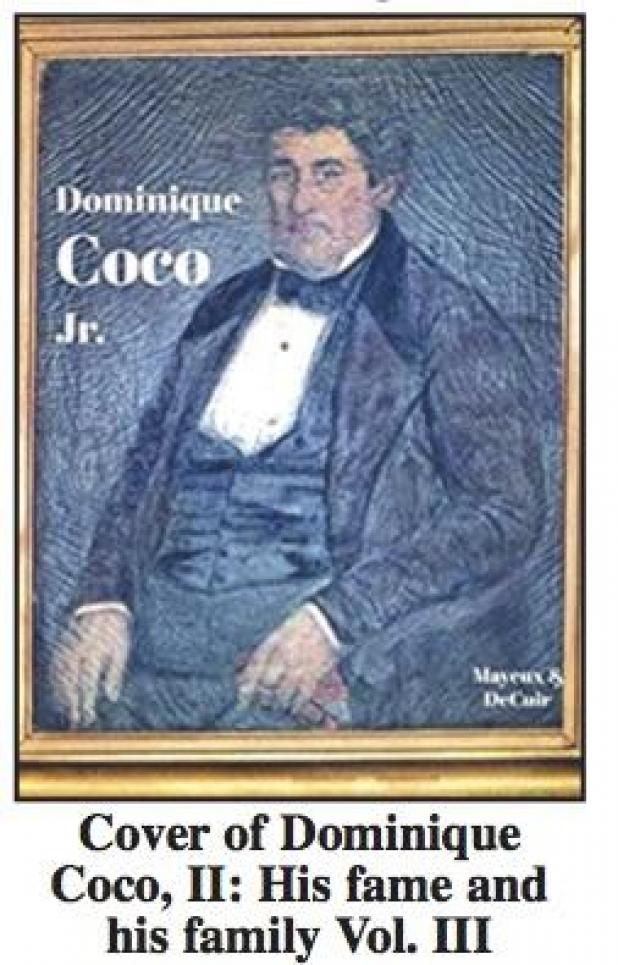
Antebellum planter Dominique Coco's story told in book form
The story of one of Avoyelles Parish' most influential families has been released in book form. "Dominique Coco, Jr" is the story the antebellum planter and his family which has been an influential part of Avoyelles history for over 200 years.
The book is volume III of a a series about Cocoville in Avoyelles Parish, Louisiana.
Vol. III Dominique Coco, II
This account tells the story of the Coco family of Avoyelles Parish, Louisiana. For over 200 years the family has been one of the most influential in the area and Louisiana.
They have been successfully involved in politics and business at all levels from international to local.
Genealogical and historical records were gathered to showcase one of the old- est of Avoyelles families.
The Cover of the book is a portraits of Dominique, taken by Chester A. Coco, who helped to pre- serve the 1800s image of his ancestor.
Dominique Coco’s father was Dominique Baldony who was a native of the French-Italian bor- der. Dominique Baldony came to America with the Marquis de Lafayette according to legends. He made his way to Pointe Coupe and became a mer- chant/peddler. He sold coconuts and according to Indians accounts became known as “l’ homme de Coco” which was French for “The Coco Man.” Arriving in Avoyelles about 1780, he settled here having married Elizabeth Rabalais. In time the family surname became Coco and the Baldony name was dropped.
Living in the Mansura area the Cocos probably built and lived in the Desfossé House. They had two sons, Dominique Coco, II and Joseph Baldwin Coco.
The elder Dominique died in 1790 and in time his widow was remarried to Guillaime Gauthier and continued to live in the Desfossé House as it became known in 1850 when Dr. Jules Charles Desfossé became the new owner.
Dominique Coco II’s land ownings were many having acquired some 16 plantations by the time of his demise in 1864. His last home was a two story brick house located overlooking the Coulee de Grues near what is today the main entrance of Paragon Casino. This home was demolished in the late 1890’s.
Coco married three times and fathered 15 chil- dren. In time this area became known as “Cocoville” and Hydropolis was seldom mentioned after that.
The history of Similien Coco is also included in that DNA tests show he was a son or grandson of Dominique Coco, II. Descendants of Similen Coco lines lived mainly along the Old River area in Mansura.
The first two books in the series are:
Volume I: Cocoville: Center of Avoyelles
The first volume “Volume I: Cocoville: Center of Avoyelles” details the earliest beginnings of Hydropolis and later the development of Cocoville in the 18th century. The first families of Avoyelles were members of the Avoyelles, Tunica-Biloxi tribes. The Tunica reserva- tion, about a mile square, was established in 1786 as a tribe by the Spanish authorities. European set- tlers arrived in the late 1700’s with most coming from Pointe Coupee Parish because of frequent flood- ing.
The following notes the major happenings in the founding and establishment of the Cocoville area that became a religious, educa- tional and financial center of Avoyelles:
(1) the land grant to the Catholic church in 1784 that later became St. Paul cemetery in Mansura and site of the first St. Paul of the Apostle Church in
1845;
(2) educational histo- ry beginning with Jerome Callegari in 1831 at the Hydropolis Church and later the Presentation Academy in 1856 and goes on to the Avoyelles Public Charter School beginning in 2000;
(3) 19th century businesses such as (a) banks of those in New Orleans: Union Bank of Louisiana and New Orleans and Carrolton Railroad, 1830’s, and (b) local stores before the Civil War belonging to Leon Drouin and Louis Roule.
And also (4) the career of Gen. Pierre Couvillon who led Louisiana troops to fight in the Mexican-Texas Wars in the 1840’s; (5) pre- Civil War homes of Hydropolis; (6) the murder of newly elected Sheriff Aurellian Coco, Jr.; (7) the murder of slave owner Laurent Normand; (8) the Civil War comes to Cocoville; (9) the original St. John Baptist Church founded in 1869; (10) the murder of Constant Guillebert c. 1886; (11) the railroad comes to Cocoville in 1895; (12) St. Paul Lutheran Church founded in 1898; (13) turn of the 1900’s memories; (14) Hydropolis school of 1907; (15) World War I and II vet- erans and (16) Modern Cocoville: Paragon Casino and Tunica-Biloxi Cultural Center.
Volume II: Hydropolis and Cocoville Early Settlers and their Families
The following family accounts are listed alphabetically with many surviving photographs: (1) Baillio; (2) Bordelon; (3) Caubarreaux; (4) Benedict Chatelain; (5) Cocoville Civil War soldiers; (6) Couvillion; (7) DeGeneres (ancestor of Ellen Degeneres); (8) De Lavallade; (9) Demouy; (10) Domas; (11) Ducote; (12) Francisco; (13) Glasscock; (14) Goux; (15) Guillebert; (16) Helminger; (17) Hudson; (18) Joffrion; (19) Lacour; (20) Laurent; (21) Lavalle-Lavalais; (22) Lehman; (23) Lemoine; (24) Maillet; (25) Marye; (26) Mayeux; (27) Dr. Moncla; (28) Neck; (29) Normand; (30) Oliver; (31) Prater: (32) Rabalais; (33) Rebouche; (34) Reynaud; (35) Rogers; (36) Roy, Sampson; (37) Schutler; (38) Siess; (39) Romain; (40) Tassin; (41) Thompson; (42) Voinche and (43) Zimmer.
Prices:
Individual books prices are: Volume 1 $20 (119 pages), Volume II $20 (106 pages), and Volume III $32 (416 pages). All are soft- bound and available at
Amazon.com.
